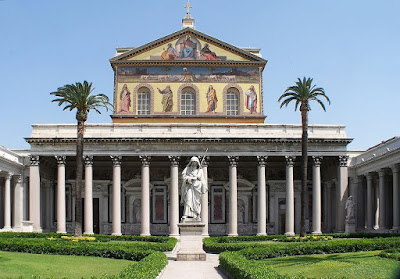The New Testament does not say when or how Paul died. The date of Paul's death is believed to have occurred after the Great Fire of Rome in July 64, but before the last year of Nero's reign, in 68.
A legend later developed that his martyrdom occurred at the Aquae Salviae, on the Via Laurentina.
Paul was decapitated, his severed head rebounded three times, giving rise to a source of water each time that it touched the ground, which is how the place earned the name St Paul at the Three Fountains ( "San Paolo alle Tre Fontane" ).
Paul's body was buried outside the walls of Rome, at the second mile on the Via Ostiensis, on the estate owned by a Christian woman named Lucina. It was here, in the 4th century, that the Emperor Constantine the Great built a first church. Then, between the 4th and 5th centuries it was considerably enlarged by the Emperors Valentinian I, Valentinian II, Theodosius I, and Arcadius. The present-day Basilica of Saint Paul Outside the Walls ( “Basilica Papale di San Paolo fuori le Mura” ) was built there in 1800.
Basilica Papale di San Paolo fuori le Mura
(Basilica of Saint Paul Outside the Walls)
The Basilica was founded by the Roman Emperor Constantine I (306-337) over the burial place of St. Paul, where a memorial was erected, called a cella memoriae. The Basilica was consecrated by Pope Sylvester (314-335) in 324.
In 386, Emperor Theodosius I (379-395) began erecting a much larger and more beautiful basilica with a nave and four aisles with a transept. It was consecrated in 390 by Pope Siricius (384-339). The work, including the mosaics, was not completed until Leo I's pontificate (440–461).
Under Pope St. Gregory the Great (590–604) the Basilica was extensively modified. The pavement was raised to place the altar directly over St. Paul's tomb.
Pope John VIII (872–882) fortified the Basilica, the monastery, and the dwellings of the peasantry, forming the town of Joannispolis which existed until 1348, when an earthquake totally destroyed it.
The cloister of the monastery was erected between 1220 and 1241.
In 1823, a fire destroyed most of the basilica. Pope Leo XII (1823-1829) ordered for reconstruction. It was re-opened in 1840, and reconsecrated in 1855
The Tomb of St. Paul
Paul's tomb is below a marble tombstone in the Basilica's crypt, at 1.37 m below the altar.
The tombstone bears the Latin inscription PAULO APOSTOLO MART ("to Paul the apostle and martyr").
The inscribed portion of the tombstone has three holes, two square and one circular. The circular hole is connected to the tomb by a pipeline, reflecting the Roman custom of pouring perfumes inside the sarcophagus, or to the practice of providing the bones of the dead with libations. The sarcophagus below the tombstone measures 2.55 m long, 1.25 m wide and 0.97 m high.





No comments:
Post a Comment